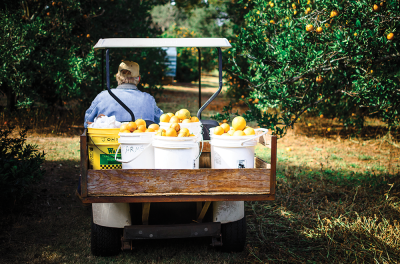 The culmination of the PIE Center’s first specialty crop block grant illustrates that the best research goes beyond technical reports.
The culmination of the PIE Center’s first specialty crop block grant illustrates that the best research goes beyond technical reports.
In addition to four research reports, PIE Center faculty and staff produced an online tool, two trade magazine inserts and countless articles and presentations over the grant’s two-year span. The PIE Center originally partnered with the Florida Specialty Crop Foundation and UF/IFAS Food and Resource Economics Department three years ago to explore consumer and farmer attitudes and behaviors concerning local food.
Following the completion of the research, the PIE Center hosted an Easy as PIE webinar with the research partners last March. Since the session, the recording has been watched more than 470 times — twice as many viewings as all other webinars.
“I really find value in the research and extension activities that the PIE Center is conducting. We made sure all 67 counties saw the outreach materials from the local food research because they help prepare our agents to have conversations with local clientele about how they can better market their produce.” — Joan Dusky, UF/IFAS Extension
With the larger goal of helping farmers and consumers connect, PIE Center educators developed an online tool to package research results and suggestions in an useful and easy-to-understand format that producers and farmers can apply to their own businesses.
The tool, called “Selling local food: Your market next door,” features interactive case studies and quizzes. Users progress through the hour-long course by collecting local fruits and vegetables for each completed section, where they earn shopping bags and coupons before checking out with the cashier.
According to the PIE Center’s external evaluation, 76 percent of users were satisfied or very satisfied with the tool, making it the highest rated of the PIE Center’s five online tools. Find out more about the evaluation on page 14.
In addition to extensive media coverage, the local food partnership highlighted the results and recommendations with informational advertising in two issues of Florida Grower. Publishing the materials in a trade publication made sure the research got to the people who could use it the most.
The two-page spreads were distributed to more than 12,000 magazine subscribers and to UF/IFAS Extension agents across the state. The map and text inform readers that consumers value the social interaction with growers and are willing to pay slightly more for a locally grown product.
Consumers in the study revealed they don’t have a standard definition for local food. Depending on the product, Floridians’ definitions of local food range from within 10 miles to within U.S. borders. Overall, most agreed that food grown within 100 miles or within the state was locally grown.
Florida sales of local food accounted for $8.3 billion in economic activity for a one-year period, with nearly three-quarters of the total estimated revenue spent at retail grocery stores. Consumers also spent $1.8 billion at farmers’ markets, roadside stands and U-pick businesses.
















